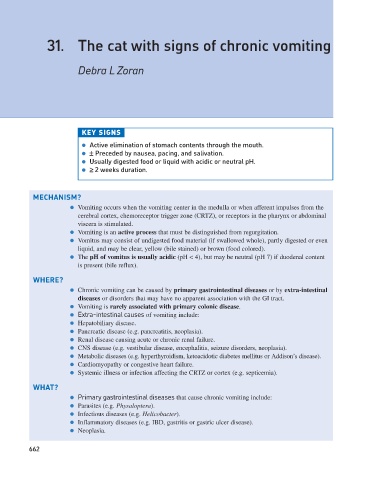Page 670 - Problem-Based Feline Medicine
P. 670
31. The cat with signs of chronic vomiting
Debra L Zoran
KEY SIGNS
● Active elimination of stomach contents through the mouth.
● ± Preceded by nausea, pacing, and salivation.
● Usually digested food or liquid with acidic or neutral pH.
● ≥ 2 weeks duration.
MECHANISM?
● Vomiting occurs when the vomiting center in the medulla or when afferent impulses from the
cerebral cortex, chemoreceptor trigger zone (CRTZ), or receptors in the pharynx or abdominal
viscera is stimulated.
● Vomiting is an active process that must be distinguished from regurgitation.
● Vomitus may consist of undigested food material (if swallowed whole), partly digested or even
liquid, and may be clear, yellow (bile stained) or brown (food colored).
● The pH of vomitus is usually acidic (pH < 4), but may be neutral (pH 7) if duodenal content
is present (bile reflux).
WHERE?
● Chronic vomiting can be caused by primary gastrointestinal diseases or by extra-intestinal
diseases or disorders that may have no apparent association with the GI tract.
● Vomiting is rarely associated with primary colonic disease.
● Extra-intestinal causes of vomiting include:
● Hepatobiliary disease.
● Pancreatic disease (e.g. pancreatitis, neoplasia).
● Renal disease causing acute or chronic renal failure.
● CNS disease (e.g. vestibular disease, encephalitis, seizure disorders, neoplasia).
● Metabolic diseases (e.g. hyperthyroidism, ketoacidotic diabetes mellitus or Addison’s disease).
● Cardiomyopathy or congestive heart failure.
● Systemic illness or infection affecting the CRTZ or cortex (e.g. septicemia).
WHAT?
● Primary gastrointestinal diseases that cause chronic vomiting include:
● Parasites (e.g. Physaloptera).
● Infectious diseases (e.g. Helicobacter).
● Inflammatory diseases (e.g. IBD, gastritis or gastric ulcer disease).
● Neoplasia.
662

